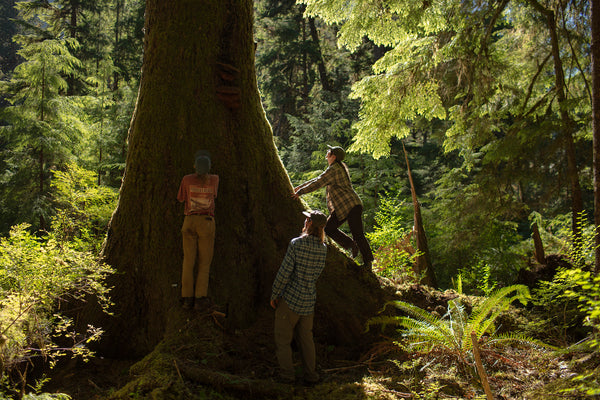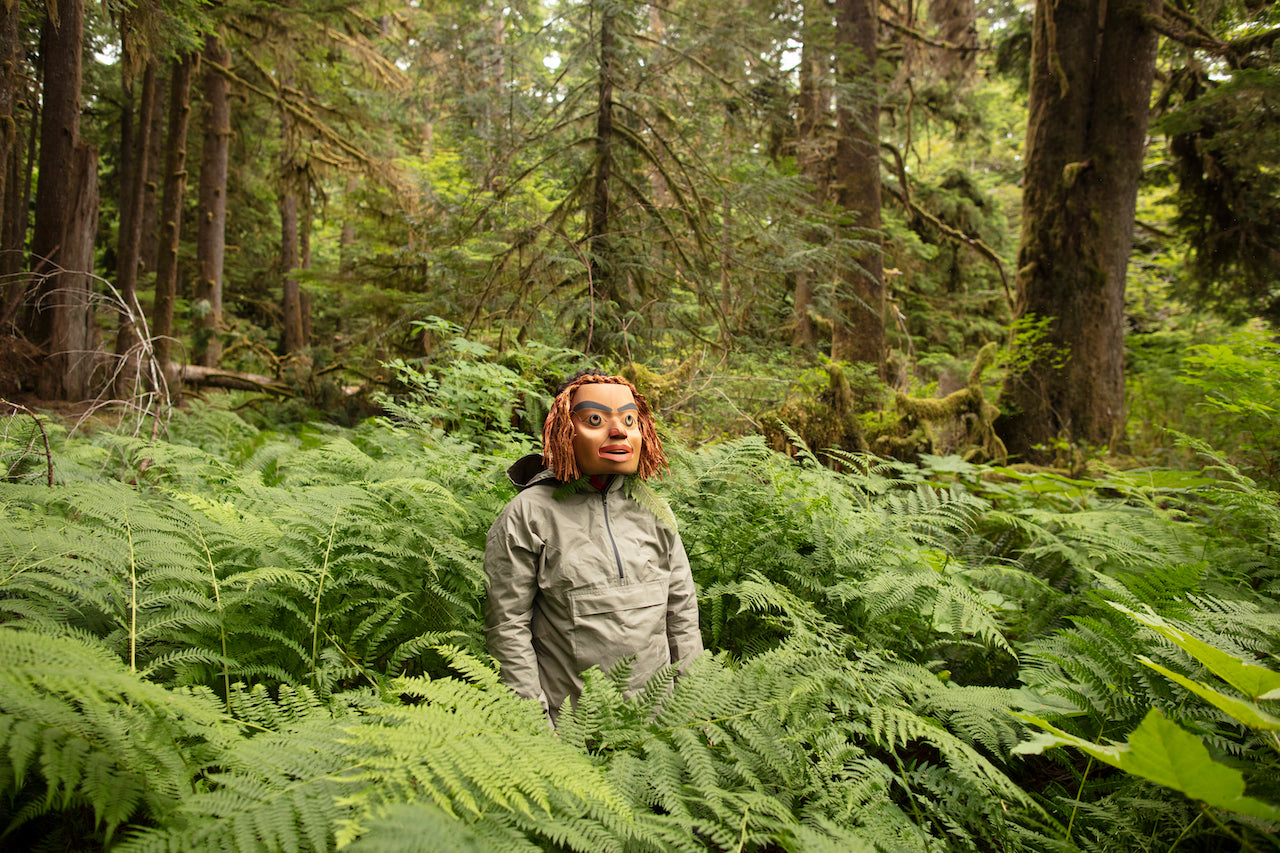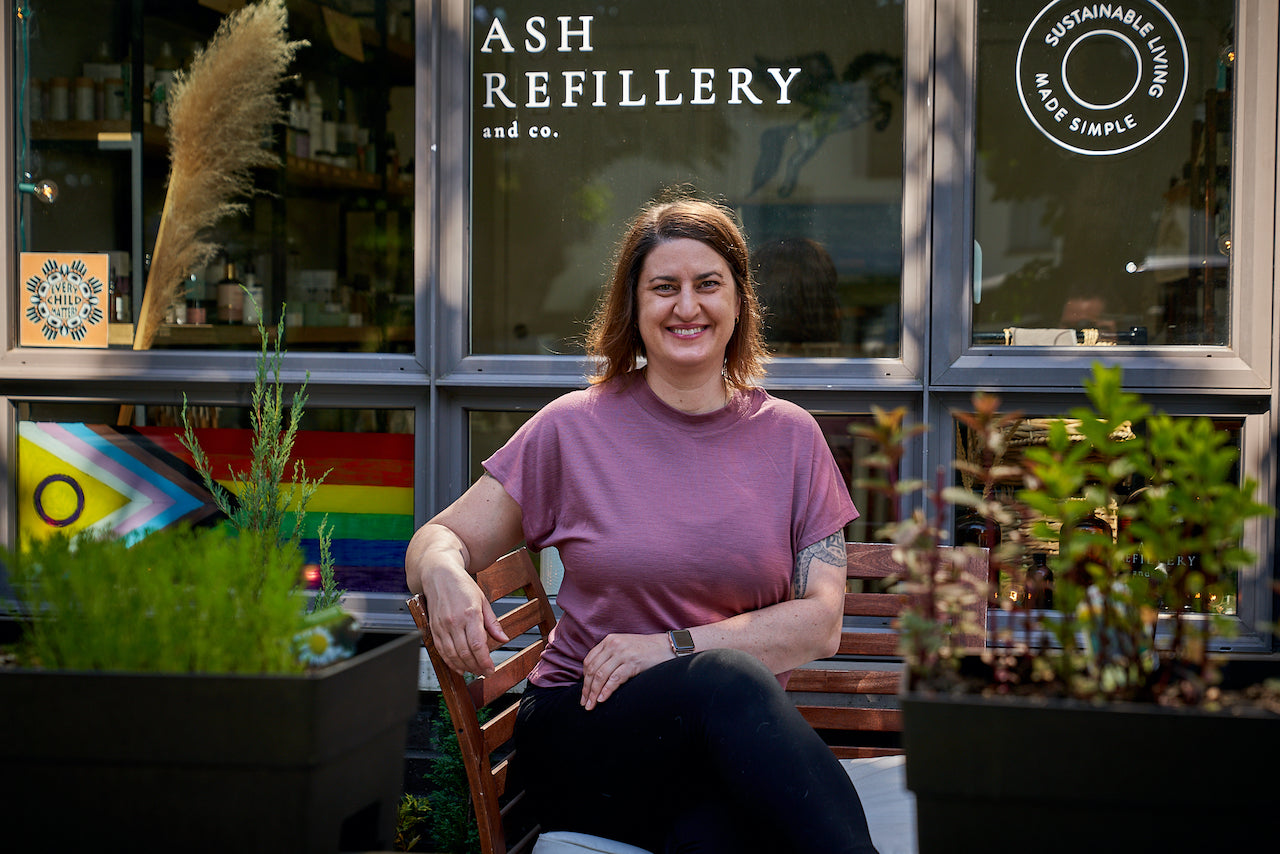Mak’wala Rande Cook has found his calling. Taking his lived experiences and skills as a multimedia artist and Hereditary Chief for the Ma’amtagila Nation in Kwakwaka’wakw Territory and bridging them with science through the Awi’nakola: Tree of Life Project. The project aims to heal the planet, heal the people, and change culture—starting with putting a halt to old growth logging in the area and regenerating second and third growth forests all while building community in the process.
Originally from the small village of ‘Yalis (Alert Bay, BC), feeling a connection with the land is in Cook’s blood. Each cedar, each shrub of salal, each balsam fir, is sacred to Cook and the other Indigenous communities who have called this coastal rainforest home since time immemorial. Balsam bark is harvested and used as medicine, known to cure cancer. Cedar bark is carefully stripped to weave baskets. Not only is old growth logging detrimental to the diverse ecosystems in which coastal plant and animal species thrive, Cook says it’s an erasure of his culture.
Awi’nakola (pronounced A-weet-nah-kyoh-lah) is a Kwak’wala word meaning “environment, including everything from the land to the ocean, and all the air in between.” Cook often says, “Maya’xala xan’s Awi’nakola.” Respect the land, ocean, air, and all living forms. He explains it doesn’t actually have a direct Anglo translation because it’s simply a way of being for Kwakwaka’wakw peoples, of coming back to the land.
“So when our elders say this,” Cook says, “it’s the embodiment of respect and relationship to all living things. And bringing people together is that first step in building community.”
Maya’xala xan’s Awi’nakola. It’s exactly why the Awi’nakola Project’s mandate is all-encompassing: when people are in alignment with the land, the land and the people can heal.

Comprised of artists, scientists, and Indigenous knowledge keepers coming together through the confluence of their work and research, the Awi’nakola Project is a research group working to keep the rich ecosystems of the some 2.7% of high productivity old growth left in the province intact. What began as an intimate, close-knit group of five in 2019, the Awi’nakola Project has grown to some 40 dedicated people working collectively to build a better future for generations to come.
It started with a phone call between Cook and Dr. Suzanne Simard, world renowned forest ecologist, University of British Columbia (UBC) professor, and author of Finding the Mother Tree, after Cook discovered her work on Mother Trees in old growth forests. He was amazed to hear of Dr. Simard’s research about the tree’s ability to communicate with their kin and other plant species through underground mycorrhizal networks and realized how closely their work mirrored one another.
“The further we began to explore and discuss our work, I started to realize everything she was saying is everything that I was also talking about,” Cook says. “It got me thinking, ‘What a beautiful relationship we could form where instead of me constantly trying to describe who we are as Indigenous people and what our values in alignment with the land are, I could use science to back it up. Suzanne’s done the work and been published. People get it. It's international, it's universal, and everybody understands what’s at stake here.’” Cook and Dr. Simard’s collective vision made sense, and soon it inspired people with an eclectic mix of skills, perspectives, and networks to become involved.

In July 2022, the growing group of Awi’nakola Project members spent a week in Kwakwaka’wakw territories documenting the loss of old growth ecosystems and coming up with ways to communicate the severity of the current state of coastal rainforests in BC. The team bore witness to the devastating pace of clearcutting within the few remaining stands of old growth forest on northern Vancouver Island, including within deferral zones. Sites of action included areas of old growth and second growth as well as fresh clear cuts; in these sites an expanded team of young scientists from Dr. Simard’s Mother Tree Project conducted research that could one day help regenerate damaged forests, and the team’s artists began to gather digital and video imagery for future works of art. Through the trip, members shared new and ancient ways of understanding the land, experienced the impact of deforestation on ecosystems and cultures, and strategized ways to shift from devastation to regeneration.
Included in the diversely skilled group is Dr. Smhayetsk Teresa Ryan, Indigenous knowledge keeper and member of the Tsimshian Nation, forest ecologist, and founder of the Salmon Forest Project speaking on behalf of the salmon and their deep connection to old growth forest ecosystems.
There’s also historical ecologist, ethnoecologist, archaeologist, and Simon Fraser University (SFU) professor Chelsey Geralda Armstrong. Armstrong is drawn to research questions that interrogate the role of colonialism and white supremacy in environmental management research and policy, exploring its deep historical roots and lasting impacts on plant communities and Indigenous lifeways. Keeping the group up-to-date with government policy and old growth deferrals is Dr. Rachel Holt, ecologist, director of Verdian Ecological Consulting, and co-author of a study on the state of old growth in the province. Dr. Holt also served on the provincial ministry’s Old Growth Technical Advisory Panel.

Along with Cook, the artists of the group are University of Victoria (UVic) visual arts professors Paul Walde and Kelly Richardson, as well as Stephanie Smith, curator, writer, arts leader, and provostial research associate at the University of Chicago’s Franke Institute for the Humanities. They, along with Cook, are keen on getting the message out through various visual art installations placed in prominent galleries and museums around the world. With Smith’s network and Cook’s, Richardson’s, and Walde’s talent, they’ve already begun securing exhibitions in locations where the government is known to purchase by-products of old growth trees.
Knowledge sharing and community bridge building is helped along by activists Kwakwaba’las, Ernest Alfred and Mark Worthing. Alfred is Hereditary Chief of the Tlowit’sis Nation and elected leader of the ‘Namgis First Nation, and is known for his leadership role in the Swanson Occupation, a protest that lasted 284 days and resulted in 35 open net fish farms being phased out in the Broughton Archipelago and Discovery Island. Worthing has worked for various environmental non-government organizations including Sierra Club BC, Greenpeace, and Sea to Cedar and is instrumental in building trust and for his knowledge of the forests on the island.
Documenting are filmmaker and producer Momme Halbe and myself, representing ecologyst and ecologyst films, along with National Geographic photographer Joshua Cogan, filmmaker Shane Alcock, and Seattle Times journalist, Lynda Mapes.
On one of the days, we visited a valley bottom patch of old growth in the heart of the Tsitika Valley. Mist hung among the trees, yet sun rays poked through the canopy, whisking it away. Though it was the middle of July, standing in that patch of coastal old growth forest, the air was so cool our breath was visible. There was a feeling of clarity among the ancient giants.
While in the forest, Dr. Simard and the Mother Tree Project scientists mapped out their plots. They drove their stakes made from fallen branches into the patches of moss and rich soil, careful not to disturb sacred herbs and medicines such as bedstraw and Pacific bleeding heart. Measuring tape was carefully wrapped around patches of salal and the trunks of towering Douglas firs to make a square. They were taking data of each of the plant species, measuring the carbon capture of each plot. Each of them marveled at the health and diversity of the soil.

Earlier that day, we had passed through a cutblock, the sharp, crisp aroma of cedar signaling the ancient Mother Trees were now gone. We spilled out of our vehicles, slowly walking up to the giants stacked in piles like dirty laundry waiting to be taken care of. The scientists immediately began counting the rings. There were trees some 500, 800, 1,000 years old. No shrub of salal or fern was spared. The forest had been decimated. The silence among the group weighed heavily.

Later, Cook and Chief Alfred held a healing ceremony for the trees. There on the dirt road in the middle of the clearcut, we joined hands and honored the lives of the trees, of whom are ancestors to Cook, Chief Alfred, and the surrounding communities. In the days that followed, deep, rich, knowledge-filled conversations were had. The group’s purpose was felt. While there were moments of intense grief, anger, and sadness, above it there was hope.

These ongoing trips are crucial to Awi’nakola: Tree of Life’s approach. They provide periods to be together on the land, share knowledge, and hatch plans for the dissemination of the outcomes of this timely, holistic research—exhibitions, publications, programs, films, and other forms of storytelling to educate, inspire, and connect others to this work. The team hopes to reach both global and local communities with its urgent but ultimately optimistic goal of combining Indigenous, scientific, and artistic knowledge to regenerate land.
Cook explains the importance of considering the next generations. “The Awi’nakola: Tree of Life project is essentially taking First Nations values and ancient philosophy around looking after and protecting mother earth and implementing it into the design of the next hundred years. We’re not saying take our culture, but take our values,” he says. “Everything I’m living and breathing right now is based on how I can do better to pave the way for not only the next generation, but for Canada, for all children.”
It’s not doing just environmental work, it’s community work. And one can’t be done without the other.
In the three months since, members from the Awi’nakola Project have spoken on panels and the group took the stage to spread the message at Rifflandia Festival in Victoria, BC, garnering the support of thousands. Plans are in action for global art exhibitions. They’re set to make an appearance at COP 15 UN Biodiversity Conference to present about the project.
To donate to the Awi’nakola: Tree of Life project, visit their website and to keep up to date, follow their work on Instagram.
Written by Kristen Bounds.
Photos by Joshua Cogan.



